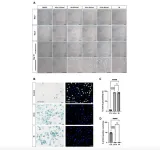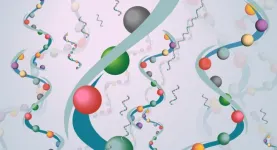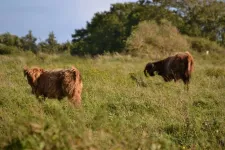(Press-News.org) MIAMI, FLORIDA (April 30, 2024) – Newly updated guidelines on neuroendocrine tumors developed by an expert at Sylvester Comprehensive Cancer Center at the University of Miami Miller School of Medicine and collaborators provide clinicians with the latest recommendations for staging and management of these rare but increasingly diagnosed tumors.
The guidelines, developed for the American Joint Committee on Cancer (AJCC) and summarized today in CA: A Cancer Journal for Clinicians, highlight recent changes for treating these tumors and offer a snapshot of this rapidly evolving field.
“There’s a lot that goes into cancer staging,” explained Aman Chauhan, M.D., who leads Sylvester’s recently established Neuroendocrine Tumor Program and was first author of the article. “Survival and outcome rates and key changes in how we diagnose these tumors are all factors that affect their staging.”
“This is the result of teamwork,” said Chanjuan Shi, M.D., Ph.D., chief of Gastrointestinal Pathology Service at Duke University School of Medicine, who led the AJCC neuroendocrine tumor version 9 expert panel and was the senior author of the article. “The expert panel members, including Dr. Chauhan, have provided critical input into the development of this updated AJCC staging system.”
Neuroendocrine tumors are cancers that form from specialized cells throughout the body that have traits similar to nerve and hormone-producing cells. Although the tumors can occur anywhere within the body, they typically arise in the digestive system or pancreas and often are diagnosed when they produce excess hormones leading to symptoms such as skin flushing, rash, gastrointestinal upset and fatigue.
Although neuroendocrine tumors are still considered rare, their incidence is rising in the U.S., from 1 in 100,000 during the 1970s to around 8 in 100,00 today. “We don’t know if the increase is due to improved diagnostic methods developed over the decades or if the cancer itself is becoming more common,” Chauhan said. He noted that researchers have linked common medications for acid reflux known as proton pump inhibitors to increased rates of gastric neuroendocrine tumors.
Chauhan, who recently led a collaboration between Sylvester and the North American Neuroendocrine Tumor Society (NANETS) to present an educational conference on managing these tumors, highlighted several key updates to the guidelines last published in 2018. They include:
A growing role for endoscopic management of neuroendocrine tumors, decreasing the need for surgery. Many tumors are detected during endoscopies or colonoscopies and can be removed simultaneously if they are small enough.
A move away from using chromogranin A (CgA) levels in the blood to screen for this cancer. These blood tests have shown no diagnostic benefit for these tumors.
Increasing use of a newer PET scan called DOTATATE imaging to stage these cancers. This type of molecular imaging uses radio-labeled peptides that bind to and light a protein often found on the surface of neuroendocrine cells, known as a somatostatin receptor. The technique not only lights all tumors within the body that have this marker, but also pinpoints tiny amounts of cancer often missed by other methods.
A focus on current outcomes data for neuroendocrine tumors from the National Cancer Database, a nationwide clinical oncology database from the American College of Surgeons.
The guidelines also identify future directions for the field, which Chauhan is helping to steer through his leadership of Sylvester’s new Neuroendocrine Tumor Program, one of the few U.S. programs for neuroendocrine cancers that treats and studies all types of these tumors and merges care and research through a multidisciplinary approach. Chauhan says the program is fulfilling an unmet need in South Florida and beyond for expertise in neuroendocrine tumors.
He is particularly excited about an emerging area of treatment related to the molecular imaging techniques highlighted in the updated guidelines. Known as theranostics, this method uses the cancer-killing power of radiation to attack tumor cells in a targeted manner. Radio-labeled peptides are first used with a low level of radiation to ensure that the drug’s target is present on the patient’s tumor. Then, a similar molecule bearing a higher level of radiation is administered as therapy, bringing radiation directly to the diseased cells. “This method avoids much of the collateral damage from traditional radiation, which irradiates both cancerous and surrounding healthy cells,” Chauhan explained.
“Many cancer treatments, including most chemotherapies, are really shots in the dark. We don’t know if they will help patients before they begin the treatment,” he continued. “That’s the beauty of this approach. It merges precision diagnosis and therapy together.”
about this work on the InventUM blog and follow @SylvesterCancer on X for the latest on its research and care.
# # #
END
Around 6,200 BCE, the climate changed. Global temperatures dropped, sea levels rose and the southern Levant, including modern-day Israel, the Palestinian territories, Jordan, Lebanon, southern Syria and the Sinai desert, entered a period of drought.
Previously, archaeologists believed that this abrupt shift in global climate, called the 8.2ka event, may have led to the widespread abandonment of coastal settlements in the southern Levant. In a recent study published with the journal Antiquity, researchers at UC San Diego, the University of Haifa and Bar-Ilan University share new evidence suggesting at least one village formerly thought abandoned not only remained occupied, but ...
“[...] these findings may help to advance our understanding of the pathogenesis of corneal endothelial disease and may lead to the discovery of new therapies targeting senescent cells.”
BUFFALO, NY- April 30, 2024 – A new research paper was published on the cover of Aging (listed by MEDLINE/PubMed as "Aging (Albany NY)" and "Aging-US" by Web of Science) Volume 16, Issue 8, entitled, “Senescent characteristics of human corneal endothelial cells upon ultraviolet-A exposure.”
In ...
Common household products containing nanoparticles – grains of engineered material so miniscule they are invisible to the eye – could be contributing to a new form of indoor air pollution, according to a Rutgers study.
In a study published in the journal Science of the Total Environment, a team of Rutgers researchers found people walking through a space, where a consumer product containing nanoparticles was recently sprayed, stirred residual specks off carpet fibers and floor surfaces, projecting them some three ...
An international team of researchers has successfully used NASA’s James Webb Space Telescope to map the weather on the hot gas-giant exoplanet WASP-43 b.
Precise brightness measurements over a broad spectrum of mid-infrared light, combined with 3D climate models and previous observations from other telescopes, suggest the presence of thick, high clouds covering the nightside, clear skies on the dayside, and equatorial winds upwards of 5,000 miles per hour mixing atmospheric gases around the planet.
The investigation is just the latest demonstration of the exoplanet science now possible with Webb’s ...
NASA’s James Webb Space Telescope has captured the sharpest infrared images to date of a zoomed-in portion of one of the most distinctive objects in our skies, the Horsehead Nebula. These observations show the top of the “horse’s mane” or edge of this iconic nebula in a whole new light, capturing the region’s complexity with unprecedented spatial resolution.
Webb’s new images show part of the sky in the constellation Orion (The Hunter), in the western side of a dense region known as the Orion B molecular cloud. Rising from turbulent waves of dust and gas is the Horsehead Nebula, otherwise known as ...
Proteins are the workhorses of life. Organisms use them as building blocks, receptors, processors, couriers and catalysts. A protein’s structure is critical to its function. Malformed proteins not only fail to carry out their tasks, they can accumulate and eventually gum up the inner workings of cells. As a result, misfolded proteins cause a variety of degenerative diseases, from Alzheimer’s and Parkinson’s to the blinding disease retinitis pigmentosa. These disorders are currently incurable.
A paper out of UC Santa Barbara reveals a new connection between ...
Researchers from the University of California San Diego have revealed new trends in drug consumption that shed light on how people are adapting to the evolving risks associated with unregulated drug use in the United States. The findings could help policymakers and public health officials better tailor interventions to meet the needs of vulnerable populations and reduce the public health burden of substance-related harm.
Since the early 2010s, deaths from accidental overdoses have been on the rise ...
Speech is critical to detecting suicidal ideation and a key to understanding the mental and emotional state of people experiencing it. Suicide hotline counsellors are trained to quickly analyze speech variation to better help callers through a crisis.
But just as no system is perfect, there is room for error in interpreting a caller’s speech. In order to assist hotline counsellors to properly assess a caller’s condition, Concordia PhD student Alaa Nfissi has developed a model for speech emotion recognition (SER) using artificial intelligence tools. The model analyzes and codes waveform modulations in ...
April 30, 2024, ALEXANDRIA, Virginia —The American Academy of Otolaryngology–Head and Neck Surgery Foundation (AAO-HNSF) published the Clinical Practice Guideline: Age-Related Hearing Loss today in Otolaryngology–Head and Neck Surgery. This clinical practice guideline (CPG) sheds lights on a global public health problem affecting approximately 466 million people worldwide and identifies quality improvement opportunities and provide clinicians trustworthy, evidence-based recommendations regarding the identification and management of age-related hearing loss (ARHL) in patients 50 years and older.
“Age-related ...
The grazing of both domestic and wild animals is shaping landscapes across Europe. It can also contribute to multiple ecosystem services, such as providing habitat for biodiversity. Grazing systems with lower densities of animals and with minimal and only targeted applications of deworming and other medicinal treatments offer benefits for local biodiversity protection and various ecosystem services. However, this type of land management also poses a range of challenges, leading to a constant decline in the number of land users engaged in low-intensity grazing. A team of researchers led by iDiv, UL, and UFZ set out to investigate these ...







